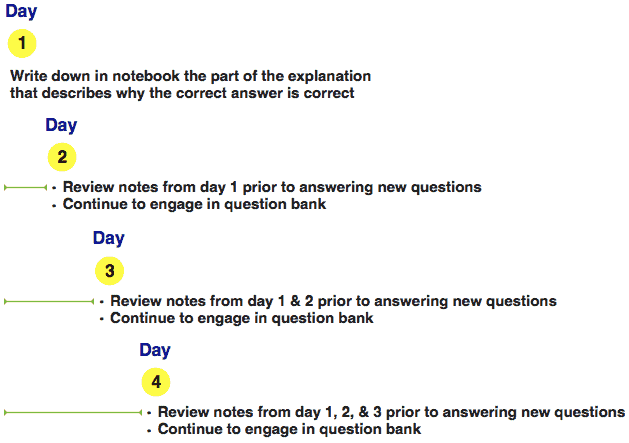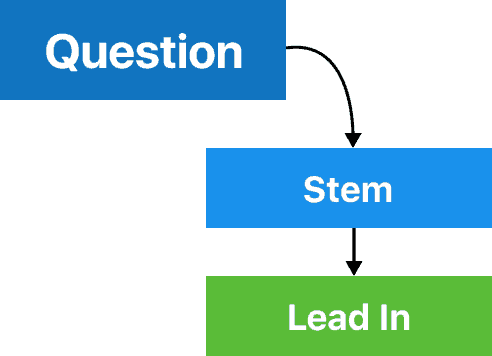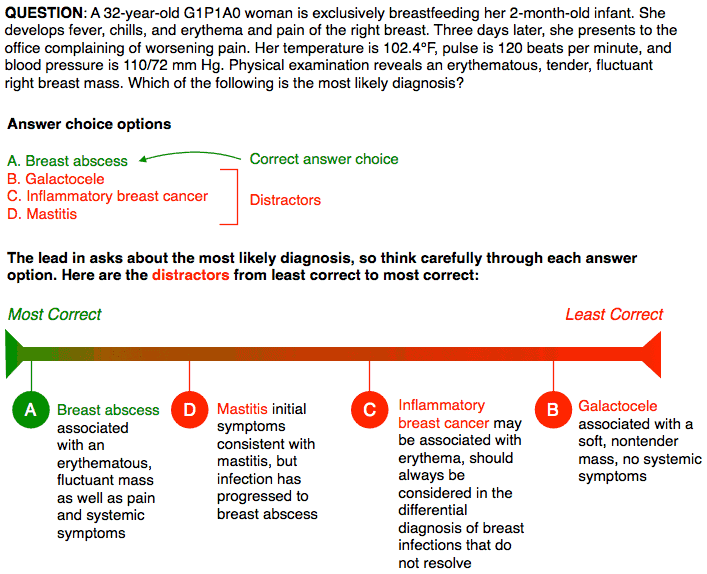How to Boost Your CREOG or ABOG OB/GYN Qualifying Exam Score

This article covers two easy strategies to help increase your likelihood of passing the Council on Resident Education in Obstetrics and Gynecology (CREOG) Exam and the American Board of Obstetrics and Gynecology (ABOG) Qualifying Exam. These two techniques are useful, easy to implement, and only require a little of your time.
The first strategy is to identify what you don‘t know. Sounds easy, right? The key is to go through a curriculum and identify what you don’t know—not what you’re weak at—but what you don’t know. The second strategy is to take advantage of human error. Humans write tests, and humans make errors. By paying attention to five types of flaws that question writers make, you can narrow down an answer choice to either the correct answer or to a 50/50 probability, even if you don’t know anything about the topic. When you combine these two strategies, you’ll be able to increase your CREOG Exam or ABOG Qualifying Exam score and increase the likelihood of passing the exam. Let’s get started.
Strategy 1: Determining your unknown unknowns
As you begin to study for an OB/GYN exam, you’ll find that there are areas you are comfortable with. Maybe you have a special interest in obstetrics and feel confident about any question on postpartum hemorrhage. Because you are confident in obstetrics you spend less time reviewing it. This is one of your known knowns—you know that you know the information. There is little utility in spending too much time on your known knowns when preparing for your exam.
During medical training, my understanding of pelvic floor disorders was poor. Apical prolapse was just a term to me. I did not understand the underlying anatomic defects, and I had a poor grasp on utilizing the Pelvic Organ Prolapse Quantification (POPQ) system to classify the degree of prolapse. Pelvic floor disorders were a known unknown. Because I recognized this specific deficiency, I was able to target my learning on the anatomy of the pelvic floor and the specifics of diagnosis and management of pelvic floor disorders.
Once I started to focus my learning, I came across many concepts and ideas that I knew nothing about…never even heard about some of them. These were the unknown unknowns, a concept created by psychologists Joseph Luft and Harrington Ingham. It is part of their “Johari window,” a tool that helps users identify blind spots about themselves and others.
Known unknowns are things you’re aware that you don’t know—you can recognize that you don’t understand them. Unknown unknowns, however, are unexpected because you don’t know they exist.
The way to supercharge your CREOG Exam or Qualifying Exam score is to identify your unknown unknowns. It takes a little effort, but the steps are rather easy. All you need are two things:

The system works like this:
Step 1: Answer a question from a question bank. If you get the answer wrong, read the explanation. Then write down in your notebook the part of the explanation that describes why the correct answer is correct. This process helps to identify your unknown unknowns. Subsequently, if there is any other information that you did not know or somewhat knew, record it in your notebook under the same topic.
You should do this for every question you get incorrect. I also encourage it for questions you may have answered correctly but discovered new information in the explanation that you previously did not know.
Step 2: Start each study session by reviewing your notebook that contains your unknown unknowns. As you do more questions, you will get questions wrong on topics you already recorded in your notebook. For example, if you answer a question incorrectly on patient selection for medical management of ectopic pregnancy, you’ll record in your notebook something like “ectopic pregnancy: contraindications for methotrexate include ruptured ectopic pregnancy, intrauterine pregnancy, breastfeeding, renal insufficiency, liver disease, active pulmonary disease, and hematologic abnormalities.” Two weeks later, if you can’t name adverse effects associated with methotrexate therapy, you should go back through your notebook to find your first entry on medical management of ectopic pregnancy and add stomatitis, conjunctivitis, alopecia, pneumonitis, dermatitis, and bone marrow suppression as potential adverse effects of methotrexate use. While we’re on the topic here’s a cheat sheet for ectopic pregnancy.
After a month or two of recording your incorrect answer explanations, you will have a filled notebook of your unknown unknowns and maybe many of your known unknowns. If you do this on a consistent basis and get through 1,000 to 2,000 question bank questions for a 300-question standardized exam, you’ll have identified most of your blind spots that questions can ask about. You will convert your unknown unknowns to known knowns.
Here is what your notebook might look like.

This is a composition notebook. All 100 pages (front and back) are filled with explanations from question bank questions I answered incorrectly.
I use the same system and process to prepare for all standardized exams. You could even use it to learn how to read EKGs better than a cardiologist.

With the CREOG Exam or Qualifying Exam around the corner, now is the perfect time to begin this system. It leaves time for adjustment and plenty of time to accumulate your unknown unknowns.
Strategy 2: Taking advantage of human error
Earlier in this post, I mentioned that you’ll need two things to supercharge your standardized exam score: a notebook and time. The notebook you can buy anytime. However, time disappears.
Taking the time to identify your unknown unknowns will prepare you for your OB/GYN exams. But, we know five ways you can improve your score simply by showing up to your exam.
You can use the errors made by question writers to boost your score.
The Anatomy of a Question
First, let’s understand the anatomy of a question.

A 32-year-old G1P1A0 woman is exclusively breastfeeding her 2-month-old infant. She develops fever, chills, and erythema and pain of the right breast. Three days later, she presents to the office complaining of worsening pain. Her temperature is 102.4°F, pulse is 120 beats per minute, and blood pressure is 110/72 mm Hg. Physical examination reveals and erythematous, tender, fluctuant right breast mass. Which of the following is the most likely diagnosis?
A question is made up of the stem and the lead-in. The stem contains the details of the question such as the clinical presentation, past medical history, and laboratory results. But, the critical part of the question is the lead-in. The question writer uses the lead-in to find out what you know or don’t know about the topic in the stem. But, it is also where question writers make errors. By applying basic grammatical analysis, you’ll be able to identify the correct answer or at least narrow down the answer choices without knowing anything about the topic. Here are our first two tips:
1. Pay attention to grammatical cues.
Grammatical cues: one or more answer choices (distractors) don’t follow grammatically from the lead-in.
A 23-year-old G1P0 woman at 38 weeks gestation presents to labor and delivery in active labor. She was treated with amoxicillin for group B streptococcal bacteriuria in the first trimester. Fetal status is reassuring and vital signs are normal. After establishing intravenous access, the best next step in management is administration of which of the following?
A. Anesthesia consult for epidural anesthesia
B. Clindamycin
C. Penicillin
D. Ultrasound
A and D do not follow grammatically from the lead-in. A good test taker can eliminate these.
2. Focus on logical cues.
Logical cues: one or more answer choices don’t logically fit in with the other choices.
A 24-year-old woman is concerned that she has endometriosis. Which of the following symptoms is most commonly seen in patients with endometriosis?
A. Dysmenorrhea
B. Dyspareunia
C. Nausea
D. Rebound tenderness
Rebound tenderness is a sign rather than a symptom and can be eliminated by a good test taker.
Let’s now focus on answer choices to identify a few more areas where we can gain an edge.

Once you understand the goal of the question writer to create answer choices that are supposed to discriminate knowledge, it is easier to exploit technical flaws and improve the odds of getting a question correct. The following three pointers round out our five tips that can help you answer a question correctly:
3. Look for answer choices containing absolute terms.
Absolute terms: terms such as “always” or “never.” When used in the answer options, these terms usually indicate an incorrect answer because they cannot hold up to scrutiny in all situations.
A 32-year-old G2P1001 woman has a positive pregnancy test and vaginal bleeding and presents for an ultrasound, which shows no fetus and has a snowstorm appearance. The human chorionic gonadotropin level is 150,000 mIU/mL. Which of the following best characterizes this type of molar pregnancy?
A. Always 46,XX
B. Hydropic chorionic villi present
C. Gestational trophoblastic neoplasia never present
D. Originates from maternal genome
A and C contain absolute terms “always” and “never.” These should be avoided in answer choices because they are less likely to be true statements.
4. Keep an eye out for a long correct answer.
Long correct answer: the correct answer is longer, more specific, or more complete than the other options.
Which of the following is a contraindication to immediate postpartum intrauterine device placement?
A. Breastfeeding
B. Cervical laceration
C. Cesarean delivery
D. Chorioamnionitis, endometritis, or other intrauterine infection
Option D is longer than the other options. The writers tend to pay more attention to the correct answer than to the distractors and write long correct answers that include additional instructional material, parenthetical information, and caveats.
5. Notice when a word repeats.
Word repeats: a word or phrase is included in the stem and in the correct answer.
A 22-year-old nulligravid woman undergoes laparoscopy for chronic pelvic pain. Peritoneal biopsies of visualized lesions demonstrate endometrial glands and stroma. Which of the following is the most likely diagnosis?
A. Adenomyosis
B. Endometriosis
C. Hemorrhagic ovarian cyst
D. Pelvic adhesive disease
This question uses the term “endometrial” in the question stem, and “endometriosis” is the correct answer.
Whether you are taking your CREOG Exam or ABOG Qualifying Exam, there is so much at stake. Taking the time to identify your unknown unknowns will not only help you prepare for and excel on your exam, it will help you expand your core knowledge. Then, on test day, use the five simple techniques you learned here to identify common flaws in questions, which will increase your chances of getting a question correct.
Give these methods a try and let me know how it goes. Moreover, I’d love to hear about techniques you use that I did not write about.
And if you are looking for an OB/GYN board review Qbank…you know where to find one.
Best,
Lindsey Penezic, MD
Get Free Access and Join Thousands of Happy Learners
You must be logged in to post a comment.





Comments (0)